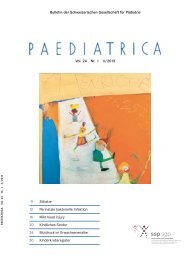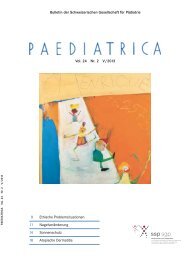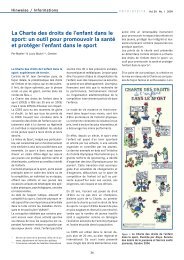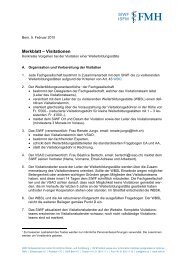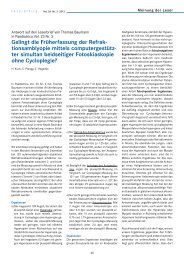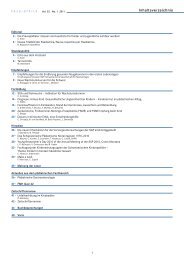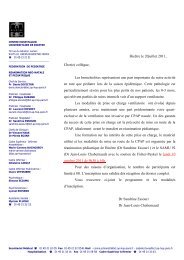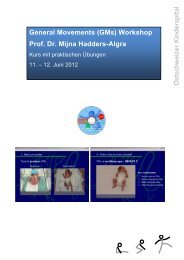Smartphone Version - Société suisse de pédiatrie
Smartphone Version - Société suisse de pédiatrie
Smartphone Version - Société suisse de pédiatrie
Erfolgreiche ePaper selbst erstellen
Machen Sie aus Ihren PDF Publikationen ein blätterbares Flipbook mit unserer einzigartigen Google optimierten e-Paper Software.
Vol. 23 Nr. 1 2012<br />
Empfehlungen<br />
lektivs <strong>de</strong>r Bun<strong>de</strong>srepublik Deutschland. Vorstellung<br />
engmaschiger Perzentilwerte (-kurven) für die<br />
Körpermasse Neugeborener. Geburtsh Frauenheilk<br />
2006; 66: 956–70.<br />
24) Bun<strong>de</strong>samt für Gesundheit, Eidgenössische Kommission<br />
für Impffragen, Arbeitsgruppe «Prävention<br />
<strong>de</strong>r Mutter-Kind-Übertragung von Hepatitis B».<br />
Empfehlungen zur Prävention <strong>de</strong>r Mutter-Kind-<br />
Übertragung von Hepatitis B. Paediatrica 2007; 18:<br />
27–32.<br />
25) Milner AD, Vyas M. Position for resuscitation. In:<br />
Milner AD, Martin RJ, editors. Neonatal and pediatric<br />
respiratory medicine. London: Butterworths;<br />
1985. p. 1–16.<br />
26) Vain NE, Szyld EG, Pru<strong>de</strong>nt LM, Wiswell TE, Aguilar<br />
AM, Vivas NI. Oropharyngeal and nasopharyngeal<br />
suctioning of meconium-stained neonates before<br />
<strong>de</strong>livery of their shoul<strong>de</strong>rs: multicentre, randomised<br />
controlled trial. Lancet 2004; 364: 597–602.<br />
27) Velaphi S, Vidyasagar D. Intrapartum and post<strong>de</strong>livery<br />
management of infants born to mothers with<br />
meconium-stained amniotic fluid: evi<strong>de</strong>nce-based<br />
recommendations. Clin Perinatol 2006; 33: 29–<br />
42, v-vi.<br />
28) Wiswell TE, Gannon CM, Jacob J, Goldsmith L, Szyld<br />
E, Weiss K, et al. Delivery room management of the<br />
apparently vigorous meconium-stained neonate:<br />
results of the multicenter, international collaborative<br />
trial. Pediatrics 2000; 105: 1–7.<br />
29) American Heart Association and American Aca<strong>de</strong>my<br />
of Pediatrics. Textbook of Neonatal Resuscitation.<br />
5 th ed. Elk Grove Village, IL: AAP/AHA Neonatal<br />
Resuscitation Steering Committee; 2006.<br />
30) Gandini D, Brimacombe JR. Neonatal resuscitation<br />
with the laryngeal mask airway in normal and low<br />
birth weight infants. Anesth Analg 1999; 89: 642–3.<br />
31) Trevisanuto D, Micaglio M, Pitton M, Magarotto M,<br />
Piva D, Zanardo V. Laryngeal mask airway: is the<br />
management of neonates requiring positive pressure<br />
ventilation at birth changing? Resuscitation<br />
2004; 62: 151–7.<br />
32) Mora EU, Weiner GM. Alternative ventilation strategies:<br />
laryngeal masks. Clin Perinatol 2006; 33:<br />
99–110.<br />
33) Davis PG, Tan A, O’Donnell CP, Schulze A. Resuscitation<br />
of newborn infants with 100% oxygen or air:<br />
a systematic review and meta-analysis. Lancet<br />
2004; 364: 1329–33.<br />
34) Saugstad OD, Ramji S, Vento M. Resuscitation of<br />
<strong>de</strong>pressed newborn infants with ambient air or pure<br />
oxygen: a meta-analysis. Biol Neonate 2005; 87:<br />
27–34.<br />
35) Saugstad OD, Rootwelt T, Aalen O. Resuscitation of<br />
asphyxiated newborn infants with room air or oxygen:<br />
an international controlled trial: the Resair 2<br />
study. Pediatrics 1998; 102: e1.<br />
36) Saugstadt OD. Resuscitation with room-air or<br />
oxygen supplementation. Clin Perinatol 1998; 25:<br />
741–56.<br />
37) Altuncu E, Ozek E, Bilgen H, Topuzoglu A, Kavuncuoglu<br />
S. Percentiles of oxygen saturations in<br />
healthy term newborns in the first minutes of life.<br />
Eur J Pediatr 2008; 167: 687–8.<br />
38) Dawson JA, Kamlin CO, Vento M, Wong C, Cole TJ,<br />
Donath SM, et al. Defining the reference range for<br />
oxygen saturation for infants after birth. Pediatrics<br />
2010; 125: e1340–7.<br />
39) Mariani G, Dik PB, Ezquer A, Aguirre A, Esteban ML,<br />
Perez C, et al. Pre-ductal and post-ductal O2 saturation<br />
in healthy term neonates after birth. J Pediatr<br />
2007; 150: 418–21.<br />
40) Rao R, Ramji S. Pulse oximetry in asphyxiated<br />
newborns in the <strong>de</strong>livery room. Indian Pediatr 2001;<br />
38: 762–6.<br />
41) Richmond S, Goldsmith JP. Air or 100% oxygen in<br />
neonatal resuscitation? Clin Perinatol 2006; 33:<br />
11–27.<br />
42) Toth B, Becker A, Seelbach-Gobel B. Oxygen saturation<br />
in healthy newborn infants immediately after<br />
birth measured by pulse oximetry. Arch Gynecol<br />
Obstet 2002; 266: 105–7.<br />
43) Dawson JA, Kamlin CO, Wong C, te Pas AB,<br />
O’Donnell CP, Donath SM, et al. Oxygen saturation<br />
and heart rate during <strong>de</strong>livery room resuscitation<br />
of infants < 30 weeks’ gestation with air or 100%<br />
oxygen. Arch Dis Child Fetal Neonatal Ed 2009; 94:<br />
F87–91.<br />
44) Vento M, Moro M, Escrig R, Arruza L, Villar G, Izquierdo<br />
I, et al. Preterm resuscitation with low<br />
oxygen causes less oxidative stress, inflammation,<br />
and chronic lung disease. Pediatrics 2009; 124:<br />
e439–49.<br />
45) Wang CL, An<strong>de</strong>rson C, Leone TA, Rich W, Govindaswami<br />
B, Finer NN. Resuscitation of preterm neonates<br />
by using room air or 100% oxygen. Pediatrics<br />
2008; 121: 1083–9.<br />
46) Wyllie J, Perlman JM, Kattwinkel J, Atkins DL,<br />
Chamei<strong>de</strong>s L, Goldsmith JP, et al. Part 11: Neonatal<br />
resuscitation: 2010 International Consensus on<br />
Cardiopulmonary Resuscitation and Emergency<br />
Cardiovascular Care Science with Treatment Recommendations.<br />
Resuscitation 2010; 81 Suppl 1:<br />
e260–87.<br />
47) O’Donnell CP, Kamlin CO, Davis PG, Morley CJ.<br />
Obtaining pulse oximetry data in neonates: a randomised<br />
crossover study of sensor application<br />
techniques. Arch Dis Child Fetal Neonatal Ed 2005;<br />
90: F84–5.<br />
48) Wyllie J, Carlo WA. The role of carbon dioxi<strong>de</strong> <strong>de</strong>tectors<br />
for confirmation of endotracheal tube position.<br />
Clin Perinatol 2006; 33: 111–9.<br />
49) Jacobs S, Hunt R, Tarnow-Mordi W, In<strong>de</strong>r T, Davis P.<br />
Cooling for newborns with hypoxic ischaemic<br />
encephalopathy. Cochrane Database Syst Rev<br />
2007: CD003311.<br />
50) Edwards AD, Brocklehurst P, Gunn AJ, Halliday H,<br />
Juszczak E, Levene M, et al. Neurological outcomes<br />
at 18 months of age after mo<strong>de</strong>rate hypothermia<br />
for perinatal hypoxic ischaemic encephalopathy:<br />
synthesis and meta-analysis of trial data. BMJ<br />
2010; 340: c363.<br />
51) Kendall GS, Kapetanakis A, Ratnavel N, Azzopardi<br />
D, Robertson NJ. Passive cooling for initiation of<br />
therapeutic hypothermia in neonatal encephalopathy.<br />
Arch Dis Child Fetal Neonatal Ed 2010; 95:<br />
F408–12.<br />
52) Pasch T, et al. Indikation für Humanalbumin-Lösungen:<br />
Ein Expertenbericht. Schweiz Med Wochenschr<br />
2000; 130: 516–22.<br />
53) Ammari AN, Schulze KF. Uses and abuses of sodium<br />
bicarbonate in the neonatal intensive care unit.<br />
Current Opinion in Pediatrics 2002; 14: 151–6.<br />
54) Beveridge CJE, Wilkinson AR. Sodium bicarbonate infusion<br />
during resuscitation of infants at birth. Cochrane<br />
Database of Systematic Reviews 2006: CD004864.<br />
DOI: 10.1002/14651858.CD004864.<br />
55) Lokesh L, Kumar P, Murki S, Narang A. A randomized<br />
controlled trial of sodium bicarbonate in<br />
neonatal resuscitation-effect on immediate outcome.<br />
Resuscitation 2004; 60: 219–23.<br />
56) Wyckoff MH, Perlman JM. Use of high-dose epinephrine<br />
and sodium bicarbonate during neonatal<br />
resuscitation: is there proven benefit? Clin Perinatol<br />
2006; 33: 141–51.<br />
57) Haddad B, Mercer BM, Livingston JC, Talati A, Sibai<br />
BM. Outcome after successful resuscitation of<br />
babies born with apgar scores of 0 at both 1 and 5<br />
minutes. Am J Obstet Gynecol 2000; 182: 1210–4.<br />
58) Jain L, Ferre C, Vidyasagar D, Nath S, Sheftel D.<br />
Cardiopulmonary resuscitation of apparently stillborn<br />
infants: survival and long-term outcome. J<br />
Pediatr 1991; 118: 778–82.<br />
59) Schweizerische Gesellschaft für Neonatologie.<br />
Betreuung von Neugeborenen ≥ 34 0/7 SSW mit<br />
erhöhtem Hypoglykämierisiko o<strong>de</strong>r Hypoglykämie<br />
im Gebärsaal und in <strong>de</strong>r Wochenbettstation. Paediatrica<br />
2007; 18: 15–7.<br />
60) Salhab WA, Wyckoff MH, Laptook AR, Perlman JM.<br />
Initial hypoglycemia and neonatal brain injury in<br />
term infants with severe fetal aci<strong>de</strong>mia. Pediatrics<br />
2004; 114: 361–6.<br />
61) Kind C. Betreuung <strong>de</strong>s Neugeborenen von Müttern,<br />
die mit Streptokokken <strong>de</strong>r Gruppe B kolonisiert<br />
sind. Paediatrica 2002; 11: 28–9.<br />
62) Schweizerische Gesellschaft für Neonatologie. Abklärung<br />
und Behandlung von ikterischen Neugeborenen<br />
ab 35 0/7 Schwangerschaftswochen. Revidierte<br />
Empfehlungen <strong>de</strong>r Schweizerichen Gesellschaft für<br />
Neonatologie. Paediatrica 2006; 17: 26–9.<br />
63) Arlettaz R, Bauersfeld U. Empfehlungen zum neonatalen<br />
Screening kongenitaler Herzfehler. Paediatrica<br />
2005; 16: 34–7.<br />
64) Guinsburg R, Wyckoff MH. Naloxone during neonatal<br />
resuscitation: acknowledging the unknown. Clin<br />
Perinatol 2006; 33: 121–32.<br />
65) American Aca<strong>de</strong>my of Pediatrics Committee on<br />
Drugs. Naloxone dosage and route of administration<br />
for infants and children: ad<strong>de</strong>ndum to emergency<br />
drug doses for infants and children. Pediatrics<br />
1990; 86: 484–5.<br />
Korrespon<strong>de</strong>nzadresse<br />
Prof. Dr. J.-C. Fauchère<br />
Klinik für Neonatologie Universitätsspital<br />
8091 Zürich<br />
Tel. 044 255 35 84<br />
Fax 044 255 44 42<br />
jean-clau<strong>de</strong>.fauchere@usz.ch<br />
23







